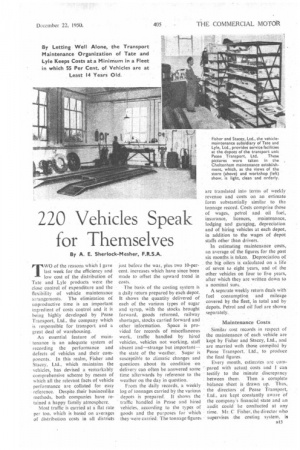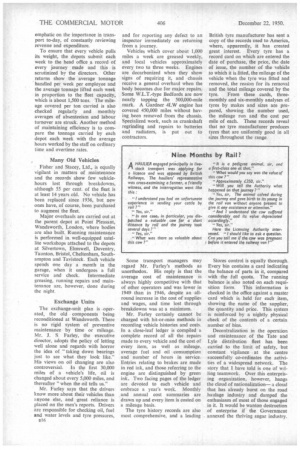220 Vehicles Speak for Themselves
Page 49

Page 50

If you've noticed an error in this article please click here to report it so we can fix it.
By A. E. Sherlock-Mesher, F.R.S.A.
TWO of the reasons which I gave last week for the efficiency and low cost of the distribution of Tate and Lyle products were the close control of expenditure and the flexibility of vehicle maintenance arrangements. The elimination of unproductive time is an important ingredient of costs control and it is being highly developed by Pease Transport, Ltd.. the company which is responsible for transport and a great deal of warehousing.
An essential feature of maintenance is an adequate system of recording the performance and defects of vehicles and their components. In this realm, Fisher and Stacey, Ltd., which maintains the vehicles, has devised a remarkably comprehensive scheme by means of which all the relevant facts of vehicle performance are collated for easy reference. Despite.their businesslike methods, both companies have retained a happy family Atmosphere.
Most traffic is carried at a flat rate per ton, which is based on averages of distribution costs in all districts just before the war, plus two 10-percent. increases which have since been made to offset the upward trend in costs.
The basis of the costing system is a daily return prepared by each depot. It shows the quantity delivered of each of the various types of sugar and syrup, with the stocks brought forward, goods returned, railway shortages, stocks carried forward and other information. Space is provided for records of Miscellaneous work, traffic handled by hired vehicles, vehicles not working, staff absent and—strange but important--the state of the weather. Sugar is susceptible to climatic changes and questions about its condition on delivery can often be answered some time afterwards by reference to the weather on the day in question.
From the daily records, a weekly log of tonnages carried by the various depots is prepared: It shows the traffic handled in Pease and hired vehicles, according to the types of goods and the purposes for which they were carried. The tonnage-figures are translated into terms of weekly revenue and costs on an estimate form substantially similar to the tonnage record. Costs comprise those of wages, petrol and oil fuel, insurance, licences, maintenance, lodging and garaging, depreciation and of hiring vehicles at each depot, in addition to the wages of depot staffs other than drivers.
In estimating maintenance costs, an average of the figures for the past six months is taken. Depreciation of the big 'oilers is caleulated on a life of seven to eight years, and of the other vehicles on four to five years, after which they are written down to
a nominal sum. • A separate weekly return deals with fuel consumptirm and mileage covered by the fleet, in total and by depots. Petrol and oil fuel are shown separately.
Maintenance Costs
Similar cost records in respect of the maintenance of each vehicle are kept by Fisher and Stacey, Ltd., and are married with those compiled by Pease Transport, ' Ltd., to produce the final figures.
Every month, estimates are compared with actual costs and I can testify to the Minute discrepancy between them. Then a complete balance sheet is drawn up. Thus, the directors of Pease Transport, Ltd., are kept constantly aware of the company's financial state and an audit Could be conducted at any time. Mr. C Fisher. the director who supervises the costing system, is emphatic on the importance in transport to-day, of constantly reviewing revenue and expenditure.
To ensure that every vehicle pulls its weight, the depots submit each week to the head office a record of every journey made and this is scrutinized by the directors. Other returns show the average tonnage handled per week per employee and the average tonnage lifted each week in proportion to the fleet capacity, which is about 1,500 tons. The mileage covered per ton carried is also checked regularly and monthly averages of absenteeism and labour turnover are struck. Another method of maintaining efficiency is to compare the tonnage carried by each depot each week with the average hours worked by the staff on ordinary time and overtime rates.
Many Old Vehicles
Fisher and Stacey, Ltd., is equally vigilant in matters of maintenance and the records show few vehiclehours lost through breakdowns, although 55 per cent. of the fleet is at least 14 years old. No vehicle has been replaced since 1936, but new ones have, of course, been purchased to augment the fleet.
Major overhauls are carried out at the parent depot at Point Pleasant, Wandsworth, London, where bodies are also built. Running maintenance is performed in well-equipped satellite workshops attached to the depots at Silvertown, Elmswell, Daventry, Taunton, Bristol, Cheltenham, Southampton and Tavistock. Each vehicle spends one day a month in the garage, when it undergoes a full service and check. Intermediate greasing, running repairs and maintenance are, however, done during the night.
Exchange Units The exchange-unit plan is .operated, the old components being reconditioned at Wandsworth. There is no rigid system of preventive maintenance by time or mileage. Mr. J. S. Farley, the executive director, adopts the policy of letting well alone and regards with horror the idea of "taking down bearings just to see what they look like." His views on oil changing are also
controversial. In the first 30,000 miles of a vehicle's life, oil is changed about every 5,000 miles, and thereafter "when the oil tells us."
Mr. Farley says that the drivers know more about their vehicles than anyone else, and -great reliance is placed on the men's reports. Drivers are responsible for checking oil, fuel and water levels and tyre pressures, r16 and for reporting any defect to an inspector immediately on returning from a journey.
Vehicles which cover about 1,000 miles a week are greased weekly, and local vehicles approximately every two to three weeks. Engines are decarbonized when they show signs of requiring it, and chassis receive a general overhaul when the body becomes due for major repairs: Some W.L.T.-type Bed fords are now nearly topping the 500,000-mile mark. A Gardner 4LW engine has covered 450,000 miles without having been removed from the chassis. Specialized work, such as crankshaft regrinding and repairs to batteries and radiators, is put out to contractors.
Some transport managers may regard Mr. Farley's methods as unorthodox. His reply is that the average cost of maintenance is always highly competitive with that of other operators and was lower in 1949 than in 1946, despite an allround increase in the cost of supplies and wages, and time lost through breakdowns was at a minimum.
Mr. Farley certainly cannot be charged with hit-or-miss methods in recording vehicle histories and costs. In a close-leaf ledger is compiled a complete record of all the repairs made to every vehicle and the cost of every item, as well as mileage, average fuel and oil consumption and number of hours in service. Entries relating to brakes are made in red ink, and those referring to the engine are distinguished by green ink. Two facing pages of the ledger are devoted to each vehicle and embrace a year's work. Monthly and annual cost summaries are drawn up and every item is costed on a mileage basis.
The tyre history records are also most comprehensive, and a leading British tyre manufacturer has sent a copy of the records used to America, where, apparently, it has created great interest. Every tyre has a record card on which are entered the date of purchase, the price, the date of issue, the number of the vehicle to which it is fitted, the mileage of the vehicle when the tyre was fitted and removed, the reason for its removal and the total mileage covered by the tyre. From these cards, threemonthly and six-monthly analyses of tyres by makes and sizes are prepared, showing the number used, the mileage run and the cost per mile of each. These records reveal that no tyre manufacturer produces tyres that are uniformly good in all sizes throughout the range Stores control is equally thorough. Every bin contains a card indicating the balance of parts in it, compared with the full quota. The running balance is also noted on each requisition form. This information is checked in the office against a master card which is held for each item, showing the name of the supplier, the quantity and price. This system is reinforced by a nightly physical check of the contents of a certain number of bins.
Decentralization in the operation and maintenance of the Tate and Lyle distribution fleet has been carried to the limit of safety, but constant vigilance • at the centre successfully co-ordinates the activities of a widespread network. The story that I have told is one of willing teamwork. Over this enterprising organization, however, hangs the cloud of nationalization— a cloud that has already burst on the road haulage industry and damped the enthusiasm of most of those engaged in it. It would be wanton destruction of enterprise if the Government annexed the thriving sugar industry.




















































































